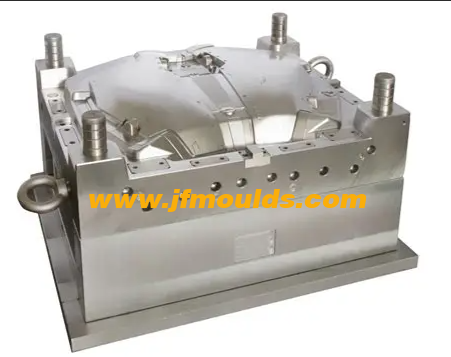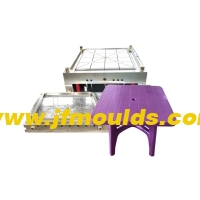The key to plastic product molding
The key to plastic product molding
Behind today's dazzling world of plastic products, injection molds play an indispensable and crucial role. From plastic tableware and electronic product casings in daily life to automotive parts and precision components for aerospace, injection molds, with their powerful molding capabilities, transform various plastic raw materials into practical items that are ubiquitous in our lives.
Auto Mould_Taizhou Jiefeng Mould Co.,Ltd. (jfmoulds.com)
The key components of injection molds
Injection molds are mainly composed of the gating system, forming parts, demolding mechanism, cooling system and mold base, etc. All parts work in coordination to ensure the smooth molding of plastic products.
The gating system, serving as the channel for the plastic melt to enter the mold cavity, is like the blood vessels in the human body, transporting the plastic melt from the injection machine nozzle to every corner of the cavity. It includes the main runner, the runner, the gate and the cold material cavity. The main runner is the starting channel for the plastic melt to enter the mold and is usually closely connected to the nozzle of the injection machine. The runner is responsible for evenly distributing the plastic melt from the main runner to each cavity. The gate is a key part that controls the speed and flow rate of plastic melt entering the cavity. Its size, shape and position have a significant impact on the quality of plastic products. The cold material cavity is used to collect the cold material generated during the injection process to prevent it from entering the cavity and affecting the quality of the product.
The formed parts are the components that directly determine the shape and size of plastic products, just like the engraving knife in a sculptor's hand, endowing plastic products with a unique appearance. It includes cavities, cores, inserts, etc. The cavity is the outer surface forming part of the plastic product, the core is used to form the inner surface of the plastic product, and the insert can be used to form the special structure or local details of the plastic product.
The function of the demolding mechanism is to smoothly remove plastic products from the mold after they are formed, preventing the products from being damaged during the demolding process. Common demolding mechanisms include ejector pins, push plates, sliders, etc. The ejector pins push out specific parts of the plastic products to separate them from the mold. Push plates are often used for demolding large-area plastic products, pushing the products out of the mold through uniform thrust. The slider is used to form plastic products with lateral grooves or protrusions. During demolding, the product can be smoothly removed by lateral movement.
The cooling system is like the "air conditioner" of the mold. Through the circulating cooling medium (such as water or cooling oil), it takes away the heat generated by the mold during the injection molding process, enabling the plastic products to cool and set quickly, thereby enhancing production efficiency and product quality. The design of the cooling system needs to take into account factors such as the structure of the mold, the shape and size of the plastic product, and the injection molding process parameters, to ensure uniform and efficient cooling.
The mold base is the supporting skeleton of the mold, providing a foundation for the installation and fixation of other components, ensuring the stability and accuracy of the mold during the injection molding process. The mold base is usually composed of fixed mold seat plates, moving mold seat plates, support plates, spacers, etc. The material and structural strength of these components have a significant impact on the service life and performance of the mold.
The meticulous selection of injection mold materials
The performance and lifespan of injection molds largely depend on the materials selected. Common injection mold materials include P20 steel, 718H steel, NAK80 steel, H13 steel and S136 steel, etc. Each of them has unique performance characteristics and is suitable for different application scenarios.
P20 steel is a pre-hardened die steel that has undergone quenching and tempering treatment before leaving the factory. It has a moderate hardness and can be directly mechanically processed without secondary heat treatment, significantly shortening the manufacturing cycle of the die. It features excellent machinability and moderate wear resistance, making it suitable for manufacturing injection molds of medium and low complexity and medium to small batch sizes, such as molds for daily necessities and household appliance components.
718H steel is an improved and upgraded version of P20 steel. By adding nickel, the purity, uniformity and comprehensive performance of the steel have been optimized. It has a higher hardness, stronger anti-deformation ability, and excellent polishing performance, reaching #6000 - #8000 mesh, approaching a mirror-like effect. 718H steel is suitable for manufacturing high-precision and long-life medium and large-sized injection molds, such as molds for precision electronic components, automotive functional parts and other products.
NAK80 steel is a pre-hardened mirror mold steel, specially designed for high-gloss and high-precision injection molds. It can achieve high hardness without heat treatment and has excellent mirror polishing performance, reaching # 10,000 - # 15,000 mesh, with extremely low surface roughness. It is the preferred material for manufacturing molds of high-transparency and high-gloss products such as optical components and cosmetic packaging.
H13 steel is a type of hot work die steel, featuring excellent heat resistance and thermal fatigue resistance. It can operate for long periods in high-temperature environments without easily experiencing thermal fatigue cracking. It has high hardness and toughness, making it suitable for manufacturing molds that are subject to high-temperature cyclic stress for long periods of time, such as molds for thick-walled or fast-cycle production products like car engine hoods and battery casings.
S136 steel is a high-chromium stainless steel die steel, renowned for its outstanding corrosion resistance and excellent polishing properties. The high chromium content endows it with extremely strong corrosion resistance, allowing it to be in long-term contact with corrosive plastics such as PVC and flame-retardant materials. Meanwhile, it has excellent polishing performance, reaching #8000 - #12000 mesh, approaching the mirror-like effect of NAK80. It is highly suitable for injection molds in medical, food packaging and other fields that have extremely high requirements for hygiene and surface quality.
The wide application of injection molds in various fields
Injection molds, with their efficient and precise forming capabilities, have been widely applied in numerous fields.
In the fieldautomotive manufacturing, injection molds are used to produce various automotive interior parts, exterior parts and functional components. Plastic products such as car instrument panels, seat armrests, bumpers and lampshades not only reduce the weight of the car and lower energy consumption, but also enhance the design freedom and aesthetic appeal of the car. The high precision and stability of injection molds ensure the dimensional accuracy and quality consistency of automotive parts, meeting the demands of large-scale production in the automotive industry.

The electronic and electrical industry is also an important application field for injection molds. Most of the shells and components of electronic products such as mobile phone casings, computer keyboards, monitor frames and home appliance shells are made by injection molding process. With the development of electronic products towards thinness, miniaturization and high performance, higher requirements have been put forward for the precision, complexity and manufacturing efficiency of injection molds. Injection mold manufacturers are constantly innovating, adopting advanced design concepts and manufacturing technologies, such as multi-cavity molds, hot runner technology, and precision processing techniques, to meet the rapidly developing demands of the electronics and electrical industry.
In daily life, injection molds are everywhere. Plastic tableware, toys, stationery, household items and other plastic products closely related to our lives are all masterpieces of injection molds. The diverse designs and large-scale production capabilities of injection molds enable these plastic products to meet People's Daily needs at a relatively low cost, enriching our lives.
Commodity Mould_Taizhou Jiefeng Mould Co.,Ltd. (jfmoulds.com)
Injection molds, as key tools for shaping plastic products, play a crucial role in modern manufacturing. With the continuous advancement of technology and the increasingly diverse market demands, injection mold technology is also constantly innovating and developing. In the future, injection molds will develop towards high precision, high efficiency, long service life, intelligence and environmental friendliness, providing stronger support for the development of various industries.
Related News
Surface roughness of mold-formed parts
2025-10-13
Surface roughness of mold-formed partsI. Representation Methods and Meanings of ...
Injection mold commonly used six kinds of mold materials
2025-06-19
The choice of steel not only affects the service life of the mold, but also affe...
The mold case integrates lines and exposed white
2025-08-04
The mold case integrates lines and exposed whiteMold fusion line:Phenomenon: The...
Surface treatment of molds
2025-07-26
Surface treatment of molds1. Common surface treatment processes The purpose o...
The causes and solutions of silver streaks, discoloration, surface ripples and roughness in injection molded products
2025-07-30
The causes and solutions of silver streaks, discoloration, surface ripples and r...
Methods for the easy breakage of the internal position of the mold and the easy damage of the screw column during the mold opening process
2025-08-07
Methods for the easy breakage of the internal position of the mold and the easy ...





